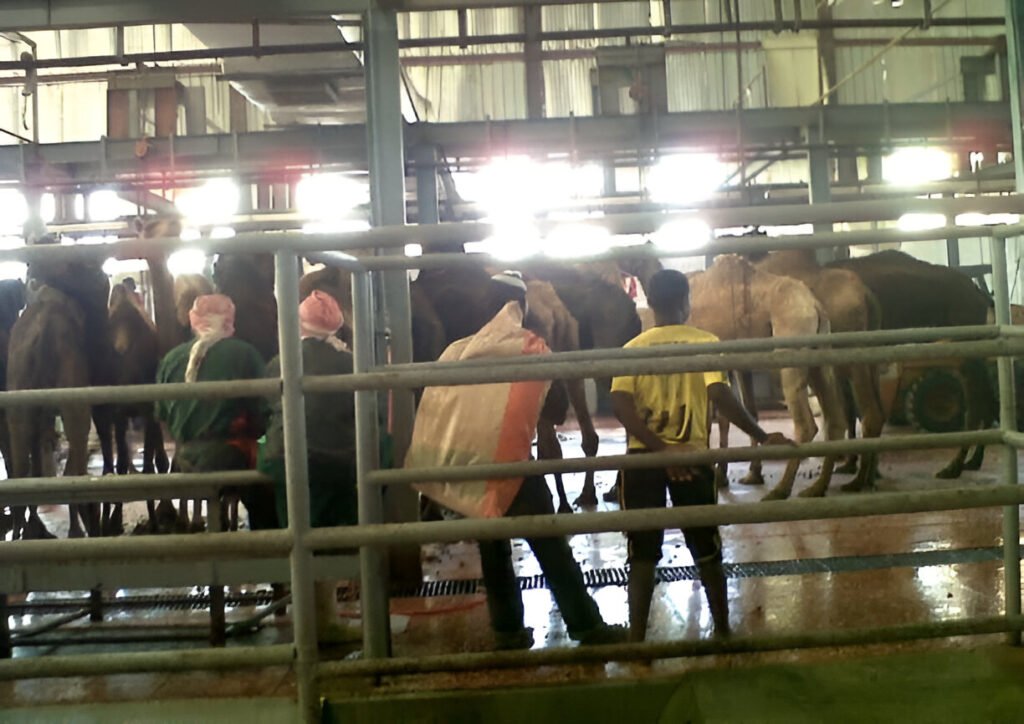- What to Do on the 10th of Dhul-Hijjah
- What Type of Animal Should Be Sacrificed
- Location for the Sacrifice
- How to Perform Hadi
- Precaution
- 10th Dhul-Hijjah Taqsir/Halq
- How Men Should Perform Halq or Taqsir
- Taqsir for Women
- After Halq or Taqsir
- Common mistakes and innovations in Hadith, Qasr, and Halq
- On the 10th of Dhul Hijjah Performing Tawaf al-Ifadah and Sa’ee
- Timing of Tawaf
- How menstruating women perform Tawaf
- After Tawaf
- Breaking the sequence of actions on the 10th of Dhul Hijjah
10th Dhul-Hijjah Hadi Sacrifice
What to Do on the 10th of Dhul-Hijjah
The act of sacrificing camels, cows, goats, sheep, or rams on the 10th of Dhul-Hijjah by pilgrims to seek Allah’s pleasure is called Hadi. Some refer to it as the Hajj Qurbani, but in reality, it is known as Hadi in the context of Hajj. There are differences between Qurbani (Udhiyah), Hadi, Dam, and Fidyah. The occasion for Qurbani is Eid-ul-Adha, while Hadi is specific to Hajj, Dam is for expiation, and Fidyah is for compensation. Qurbani can be performed anywhere in the world, but Hadi, Dam, and Fidyah must be performed within the boundaries of the Haram. The meat of Hadi and Qurbani can be consumed by oneself, but the meat of Dam and Fidyah cannot be eaten by the person performing them. Pilgrims performing Hadi during Hajj are not obligated to perform Qurbani in that year but may choose to do so. Hadi can be performed from sunrise on the 10th of Dhul-Hijjah until sunset on the 13th of Dhul-Hijjah. Tamattu’ and Qiran pilgrims must perform the Hadi sacrifice.
Allah says: “Whoever performs Umrah during the Hajj months, followed by Hajj, should offer the sacrificial animal that can be afforded.” Surah Al-Baqarah: 2:196
Those unable to afford a Hadi must fast for three days in Makkah after Hajj and seven days upon returning home (consecutively or non-consecutively). Residents of Makkah are not required to perform Hadi or fast. Bukhari 1997, 1998
What Type of Animal Should Be Sacrificed
The Hadi animal can be male or female. The minimum age for animals is as follows: a ram must be six months old, a sheep one year, a goat one year, a cow two years, and a camel five years. The animal should not be one-eyed, sick, lame, extremely weak, have broken horns, or have torn ears. Ibn Majah 3144, Tirmidhi 1497
If the Hadi is a camel or cow, it can be shared by up to seven individuals. For a sheep or goat, one animal is required per individual. The meat can be consumed by the person and brought back home. Bukhari 1688, 1719; Muslim 3076
Location for the Sacrifice
Hadi can be performed anywhere within the Haram, including Makkah and Mina, as the Prophet (peace be upon him) said: “I sacrificed here, and all of Mina is a place of sacrifice.” Abu Dawood 1907, Ibn Majah 3048
However, in the Mina tent area, you won’t find locations for Hadi sacrifices. There is a designated place called Mu’aysim within Mina’s boundaries for Hadi sacrifices.
How to Perform Hadi
Hadi can be performed in three ways: through a bank, via your Hajj agency, or by purchasing and sacrificing an animal directly.
Performing Hadi through a bank is the best option. Before Hajj, deposit 450/500 Riyals at Al-Rajhi Bank or another bank and collect a receipt or ticket. The ticket will mention the approximate time of the sacrifice (e.g., 10 AM/11 AM). Usually, the bank begins the sacrifices from the morning of the 10th of Dhul-Hijjah, and the sacrifice may occur before or after the specified time. Many small bank booths in Makkah and Madinah accept Hadi payments. It is better to purchase the ticket before Hajj, as they may sell out later.
Alternatively, you can give the money to your Hajj agency, which can arrange for Hadi animals in Mina. They can handle the process on your behalf.
You may also go to the animal market in Mina, purchase an animal, and perform the sacrifice yourself. In this case, you may take some meat for consumption. However, for general pilgrims, visiting the market can be challenging and requires significant effort, so it’s better to choose the first two methods.
Performing the sacrifice with your own hands is Sunnah. The Prophet (peace be upon him) sacrificed seven camels. While sacrificing, the animal should face south, lying on its left side with its legs on the right. The person performing the sacrifice should face the Qibla while cutting. Bukhari 1712
The supplication to recite at the time of sacrifice:
بِسْمِ اللَّهِ وَاللَّهُ أَكْبَرُ، اللَّهُمَّ تَقَبَّلْ مِنّي
“In the name of Allah, Allah is the Greatest. O Allah, accept this from me.”
Precaution
During Hajj, some dishonest people come to the Mina tents claiming to arrange Hadi sacrifices, providing fake receipts and collecting money without actually performing the sacrifice. Some Hajj agencies also commit similar fraud. Therefore, if arranging Hadi through an agency, some group members should visit the agency and witness the sacrifice process.
10th Dhul-Hijjah Taqsir/Halq
After the Hadi sacrifice on the 10th of Dhul-Hijjah, it is mandatory to trim hair evenly from all parts of the head (Taqsir) or shave the head completely (Halq). Shaving is preferred. In the Qur’an, shaving is mentioned before trimming. The Prophet (peace be upon him) and most of his companions shaved their heads. Abu Dawood 1980
The Prophet (peace be upon him) made supplication for those who shaved their heads three times and for those who trimmed their hair once. Allah says in the Qur’an: “Some of you will shave their heads, and some will trim their hair.” It is mentioned in a hadith: “Shaving the head earns a reward for every hair and forgiveness for a sin.” Surah Al-Fath 48:27, Bukhari 1728, Muslim 3041
How Men Should Perform Halq or Taqsir
During this time, you will see barbers on the streets with electric razors, trimmers, or blades charging 20–30 Riyals. They will shave your head in 2–4 minutes. Ask the barber to begin shaving from the right side of your head, as the Prophet (peace be upon him) did. You may also shave each other’s heads if you have razors or blades. The person performing the shave does not need to have their hair shaved beforehand. Muslim 3043, Abu Dawood 1982, Tirmidhi 912
Taqsir for Women
Women should cut one-third of a finger’s length (approximately one inch) from the front of their hair. Women are not allowed to shave their heads. Abu Dawood 1984
After Halq or Taqsir
Now, remove your Ihram clothing and take a bath if necessary. Put on regular clothing. Exiting Ihram is a Wajib act of Hajj. This is called Tahallul al-Asghar, or the preliminary release. At this point, all Ihram restrictions except sexual relations are lifted. You can now use perfume. Nasai 3084
After becoming Halal, if you wish, go to Makkah on the 10th of Dhul Hijjah for Tawaf al-Ifadah and Sa’ee and return to Mina before midnight. If you feel too tired that day, you can stay in Mina overnight and perform Tawaf and Sa’ee on the 11th or 12th of Dhul Hijjah. Continue reciting Takbeer Tashreeq.
Qasr (trimming hair)
Halq (shaving the head)
Common mistakes and innovations in Hadith, Qasr, and Halq
Not performing Hadi but donating an equivalent amount to a charitable cause instead.
Starting to shave the head from the left side.
Shaving part of the head and trimming the rest.
Assuming that facing the Qiblah while shaving is obligatory.
Cutting some hair from different parts of the head with scissors and storing it in a box.
On the 10th of Dhul Hijjah Performing Tawaf al-Ifadah and Sa’ee
On the 10th of Dhul Hijjah, performing this Tawaf, also known as Tawaf az-Ziyarah, is one of the pillars of Hajj. Tawaf al-Ifadah and Sa’ee are Fard acts of Hajj. If you wish to go to Makkah from Mina for this Tawaf, you can go in two ways. One: Walk past the Jamarat via the pedestrian tunnel. Two: hire a car or motorcycle from the King Faisal overpass or near the Jamarat. If you have already gone to Makkah/Aziziyah/Shisha after shaving your head, you can go for Tawaf from your hotel or accommodation.
Timing of Tawaf
The Prophet (PBUH) performed this Tawaf on the 10th of Dhul Hijjah after the sun had moved past its zenith. However, this Tawaf can be performed anytime after sunrise that day. It is recommended to complete it before sunset on the 10th of Dhul Hijjah. If there is hardship or difficulty, it can be done anytime before sunset on the 12th of Dhul Hijjah. Some scholars state that it can be performed anytime until the end of the month of Dhul Hijjah. Everyone must perform their Tawaf personally. Delegating someone else to perform Tawaf on your behalf is not allowed. If necessary, you can use a wheelchair to complete the Tawaf and Sa’ee. Muslim 3056
This Tawaf is performed like any other general voluntary Tawaf done in Makkah. There is no Ihram clothing, Idtibah, or Raml required for this Tawaf. Wear regular clothes while performing it. During the 10th to 12th of Dhul Hijjah, there is usually a heavy crowd for this Tawaf, so adjust according to the situation and complete it in a less crowded area. Ibn Majah 3060
How menstruating women perform Tawaf
Menstruating women should wait to perform this Tawaf. Sa’ee cannot be done before Tawaf. It must follow Tawaf. Once menstruation ends, perform the Tawaf. No sacrifice is required in this case. If the situation is such that the woman cannot wait for her menstruation to end due to leaving Makkah and having no opportunity to return to perform Tawaf az-Ziyarah later, most scholars suggest that she should properly secure herself and perform Tawaf and Sa’ee.
After Tawaf
After completing Tawaf, pray two Rakats of Salah behind Maqam Ibrahim or anywhere in Masjid al-Haram. Then drink Zamzam water and pour some on your head. Go to Mount Safa and perform Sa’ee, just like during Umrah. There is no need to cut your hair after this Sa’ee.
After completing this Tawaf and Sa’ee, sexual relations will also become Halal. This is called Tahallul al-Akbar, or complete release from Ihram restrictions.
After completing the Tawaf and Sa’ee on the 10th of Dhul Hijjah, return to Mina before midnight on the 11th of Dhul Hijjah to spend the nights of Ayam al-Tashreeq. Perform all Salah at the earliest time and in Qasr form.
Breaking the sequence of actions on the 10th of Dhul Hijjah
This is a contentious issue. It is crucial to learn about it before going for Hajj. Some will insist on following the order of actions on the 10th of Dhul Hijjah, which is correct and Sunnah. However, if the sequence is unintentionally broken, some may suggest offering a sacrifice as compensation, which is not correct. Authentic hadiths indicate that there is no penalty for breaking the sequence. Allah is Most Merciful and does not impose undue hardship on His servants. Using common sense will help discern right from wrong.
If, on the 10th of Dhul Hijjah, actions are not performed in order due to ignorance or any difficulty, there is no penalty. However, intentionally breaking the sequence is not appropriate. For example, if you arranged Hadi through a bank, and your voucher states the Hadi will be performed at 10 a.m., you will trim your hair and exit Ihram after 11 a.m. However, if your Hadi is delayed, the sequence may break without your knowledge. There is no sin or fault on your part in such cases.
Performing the actions of the 10th of Dhul Hijjah in sequence is Sunnah, such as stoning, Hadi, shaving, Tawaf al-Ifadah, and Sa’ee. However, if someone unintentionally performs them out of sequence due to any reason, there is no harm. Several hadiths narrate that people asked the Prophet (PBUH) about actions done out of sequence, such as performing Hadi before stoning, shaving before performing Hadi, or performing Tawaf before shaving. The Prophet (PBUH) consistently replied, “No harm,” “No problem,” or “No fault.” Bukhari 1722, 1736; Muslim 3047; Abu Dawood 1983, 2014; Tirmidhi 916; Ibn Majah 3049



